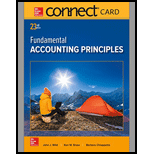
Introduction:
Treasury Stocks are the stocks which are those numbers of issued stocks which are repurchased by the corporation. In other words,
Requirement 1
To Determine:
Answer to Problem 2BPSB
Solution:
| Date | Particulars | Debit | Credit |
| Jan.1 | Treasury Stock, $12 par value | 480,000 | |
| Cash | 480,000 | ||
| (40,000 Common Stock repurchased at $12) | |||
| Jan.5 | 240,000 | ||
| Dividend Payable | 240,000 | ||
| (Cash Dividend of $1.5 on each outstanding share declared) | |||
| Feb.28 | Dividend Payable | 240,000 | |
| Cash | 240,000 | ||
| (Cash Dividend paid) | |||
| July.6 | Cash | 312,000 | |
| Additional paid-in-capital | 24,000 | ||
| Treasury Stock | 288,000 | ||
| (Treasury stock sold out above cost) | |||
| Aug.22 | Cash | 152,000 | |
| Additional Paid-in-Capital- Treasury Stock | 24,000 | ||
| Retained Earnings | 16,000 | ||
| Treasury Stock | 192,000 | ||
| (Treasury Stock sold out below cost) | |||
| Sep.5 | Retained Earnings | 500,000 | |
| Dividend Payable | 500,000 | ||
| (Cash Dividend declared) | |||
| Oct.28 | Dividend Payable | 500,000 | |
| Cash | 500,000 | ||
| (Cash Dividend paid) | |||
| Dec.31 | Income Summary | 1,072,000 | |
| Retained Earnings | 1,072,000 | ||
| (Credit balance of net income transferred to retained earnings) |
Explanation of Solution
Explanations:
1. Calculation of Cash Dividend declared on Jan.5:
2. Calculation of Cash Dividend declared on Sep.5:
Requirement 2:
To Calculate:
Ending Balance of Retained Earnings
Answer to Problem 2BPSB
Solution:
Balthus Corporation
Statement of Retained Earnings
For the year ended 31st Dec. 2017
| Particulars | Amount ($) |
| Retained Earnings on December 31, 2016 | 2,160,000 |
| Net Income for the year ended Dec.31, 2017 | 1,072,000 |
| Dividend paid to Shareholders | (740,000) |
| Treasury Stock reissuances | (16,000) |
| Retained Earnings at Dec.31, 2017 | 2,476,000 |
Explanation of Solution
Explanations:
The statement of retained earnings shows the changes in retained earnings during an accounting year. It generally starts with an opening balance of retained earnings and then different items of income and expenses are added and subtracted to arrive at the closing balance of retained earnings for the said accounting year. This can be calculated as follows:
Requirement 3:
To Calculate:
Answer to Problem 2BPSB
Solution:
Total Stockholders’ Equity at the year-end is $4,076,000
Explanation of Solution
Explanations:
| Common stock- $10 par value, 100,000 shares authorized | |
| 40,000 shares issued and outstanding | $200,000 |
| Paid-in-Capital in excess of par value, common stock | 1,400,000 |
| Retained Earnings | 2,476,000 |
| Total Stockholders’ Equity | 4,076,000 |
Want to see more full solutions like this?
Chapter 13 Solutions
Connect Access Card for Fundamental Accounting Principles
- Can you help me find the accurate solution to this financial accounting problem using valid principles?arrow_forwardCalculate the maintenance cost that would be budgeted for a month in which 5,800 machine hours are planned to be used.arrow_forwardPlease need help with this general accounting questionarrow_forward
- Peninsula Manufacturing has sales of 1,750,000, costs of 840,000, depreciation expenses of 120,000, and interest expenses of 45,000, with a tax rate of 25 percent. A. Calculate the net income for the firm. B. If the company paid out $115,000 in cash dividends, calculate the increase to retained earnings.arrow_forwardI am looking for help with this general accounting question using proper accounting standards.arrow_forwardCan you explain the correct approach to solve this general accounting question?arrow_forward
- Aarav Distillers has estimated budgeted costs of $63,000, $74,400, and $85,800 for the manufacture of 3,000, 4,000, and 5,000 liters of wine, respectively, for the next quarter. What are the variable and fixed manufacturing costs in the flexible budget?arrow_forwardThe standard materials cost of WoodWorks' product is $75 per unit, based on 25 pounds of raw materials at a standard cost of $3 per pound. During April 20X9, 1,500 units of product were produced, using 38,500 pounds of raw material at a cost of $3.20 per pound. a) The standard cost for materials for April is . b) The total materials variance for the month is . c) The materials quantity variance is . d) The materials price variance is .arrow_forwardPlease provide the correct answer to this general accounting problem using valid calculations.arrow_forward

 AccountingAccountingISBN:9781337272094Author:WARREN, Carl S., Reeve, James M., Duchac, Jonathan E.Publisher:Cengage Learning,
AccountingAccountingISBN:9781337272094Author:WARREN, Carl S., Reeve, James M., Duchac, Jonathan E.Publisher:Cengage Learning, Accounting Information SystemsAccountingISBN:9781337619202Author:Hall, James A.Publisher:Cengage Learning,
Accounting Information SystemsAccountingISBN:9781337619202Author:Hall, James A.Publisher:Cengage Learning, Horngren's Cost Accounting: A Managerial Emphasis...AccountingISBN:9780134475585Author:Srikant M. Datar, Madhav V. RajanPublisher:PEARSON
Horngren's Cost Accounting: A Managerial Emphasis...AccountingISBN:9780134475585Author:Srikant M. Datar, Madhav V. RajanPublisher:PEARSON Intermediate AccountingAccountingISBN:9781259722660Author:J. David Spiceland, Mark W. Nelson, Wayne M ThomasPublisher:McGraw-Hill Education
Intermediate AccountingAccountingISBN:9781259722660Author:J. David Spiceland, Mark W. Nelson, Wayne M ThomasPublisher:McGraw-Hill Education Financial and Managerial AccountingAccountingISBN:9781259726705Author:John J Wild, Ken W. Shaw, Barbara Chiappetta Fundamental Accounting PrinciplesPublisher:McGraw-Hill Education
Financial and Managerial AccountingAccountingISBN:9781259726705Author:John J Wild, Ken W. Shaw, Barbara Chiappetta Fundamental Accounting PrinciplesPublisher:McGraw-Hill Education





